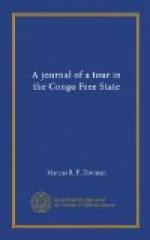but welcomes the formation of private companies who
will help them in their gigantic undertaking.
It is difficult to realise that probably no man, white
or black, has ever set foot in the forest a few hundred
yards away, and yet we are travelling smoothly along
a steel railroad through a tractless desert of trees
propelled by a modern steam locomotive. The line
does not pass near a single native village, for this
part is not thickly populated and the only creatures
whose paths are interrupted, are the elephants, buffaloes
and wild pigs. On our return we visit the house
of Mr. Adams, a solid structure of brick and European
cement, and the Mess of the thirty or forty whites
employed on the line who live here very well for mutton
as well as goat can be purchased from the natives.
The price of everything which has to be carried from
Europe is very high at Stanleyville for the cost of
transport is very great. In the afternoon, we
make a tour of the town, and as it is impossible to
walk, I am conveyed in a kind of bathchair resting
on one wheel. One boy goes in front and one behind
and when the road is very bad or an obstacle is met,
they lift the machine bodily over it. It is however,
a bumpy ride, for the roads are very rough and the
chair has no springs. We pass the Mess, capable
of dining sixty men and visit the prison. This
is a brick building arranged as a quadrangle with
an exercising yard in the centre. The cells are
lofty and airy and only one prisoner occupies each,
but many sleep in one dormitory. Everywhere great
cleanliness is observed, so that one is not altogether
surprised to learn that the mortality due to Sleeping
Sickness is very small among the prisoners. Some
of them are making mats and baskets in the yard, but
most are working on the chain outside. In a separate
building, the women, who also wear light chains, are
cooking dinner for the prison. Indeed, on the
whole the lot of a prisoner in the Congo is better
than he would be likely to experience in a native village,
with the exception that he is compelled to work.
Most of the people are sentenced for theft or violence,
but one woman was imprisoned for throwing a solution
of pepper into the face of her husband and nearly
blinding him. There is a separate room set apart
for white prisoners, but it has not yet been used
and is at present much more satisfactorily occupied
by the instruments of the band of the Force Publique.
Near the Mess we pass the house of Tippo-Tip, a small
mud structure with a verandah and a roof of grass.
It is not used at all now, but is allowed to remain
as an historical monument. Stanley was compelled
to negotiate with Tippo in order to avoid a conflict
at the time when the State was not sufficiently armed
to undertake such a task but since then, Arab rule
has been entirely driven from Central Africa.
Almost opposite the Falls, a fort is being constructed
with a ditch all round. When finished, it will
be capable of holding the whole garrison and supplies
for eighteen months. It is of course, only constructed
as a defence against native attacks and is not built
strong enough to resist big gun fire.




